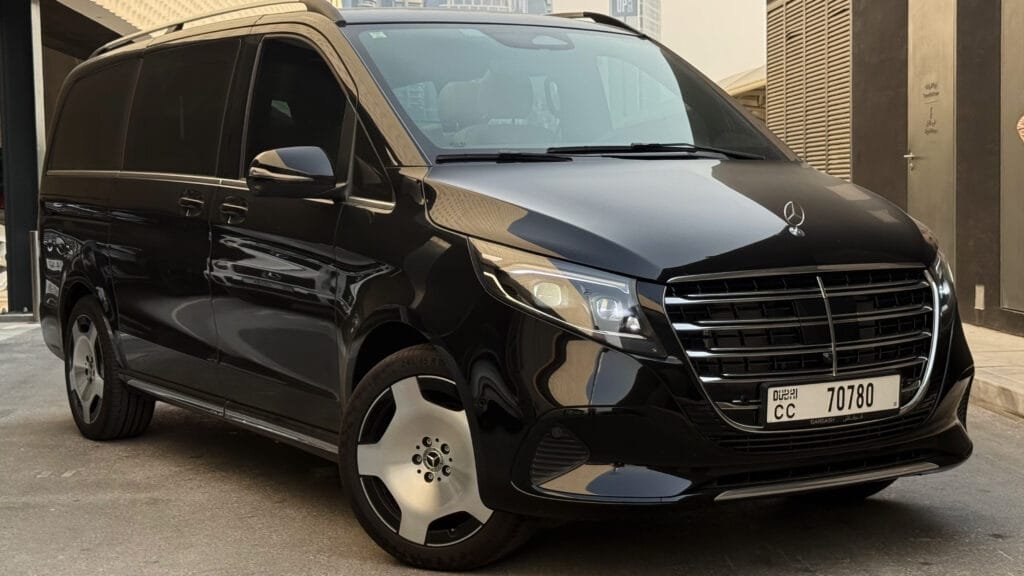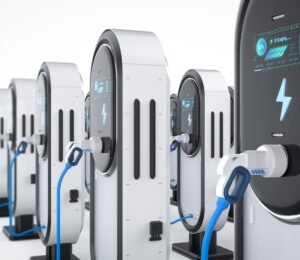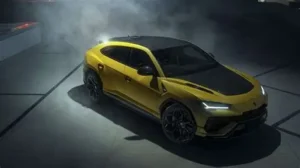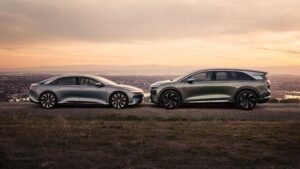Mercedes-Benz has repositioned its V-Class (and sibling EQV electric) as a top-tier luxury people carrier. The refreshed V-Class emphasizes premium styling and advanced technology to serve diverse roles – from a high-end family shuttle to executive transport or VIP hotel shuttle . Mercedes notes that this update gives the V-Class “greater visual appeal” and more digital features, moving many once-optional features into standard equipment for a more attractive overall package . Even at the upper end of the MPV market, the V-Class now competes as an “opulent luxury shuttle,” though alternatives like the Volkswagen Caravelle (and VW’s upcoming Multivan) and Toyota’s luxury people-movers remain in sight .
Distinctive New Design
The V-Class receives a bolder exterior design to set it apart in the MPV segment. A prominently redesigned grille and bumper give a distinctive face, often framed by a thin LED light band. High-end EXCLUSIVE models even sport an upright Mercedes star on the hood for the first time . Adaptive MULTIBEAM LED headlights (84 individually-controllable LEDs) further add to the modern look, while a new chrome strip with “Mercedes‑Benz” script and sleek LED taillights create an unmistakable rear signature . The facelift also brings new alloy wheel designs (up to 19″) and several fresh paint colors. Practical touches include standard dual sliding side doors (one on each side) for easy access, addressing a frequent business-fleet request .
- Key features: Striking radiator grille, redesigned bumper, LED light band (depending on trim) .
- Lighting: Adaptive MULTIBEAM LED headlamps with Highbeam Assist PLUS and darkened-contour rear LEDs .
- Wheels & Color: New aerodynamic alloy wheels (17–19″) and additional exterior paint choices, enhancing the premium look.
Modern, Tech-Rich Interior
Inside, the V-Class cabin is comprehensively revamped with a high-tech, luxurious feel. The cockpit now features two 12.3-inch widescreen displays integrated into a single housing – one for the digital instrument cluster and one for the MBUX infotainment . A new steering wheel (with touch controls and optional capacitive “hands-off” recognition) and jet-engine-style air vents underline the updated aesthetic. The center console supports optional wireless smartphone charging, and convenience features like KEYLESS start, a heated steering wheel, and multicolor ambient lighting (64 colors) enhance comfort . Materials are stepped up with soft-touch surfaces and leather-trimmed panels, especially in higher trims . Passengers enjoy a light and airy ambience thanks to a panoramic sunroof and large windows.
- Displays & Controls: Twin 12.3″ digital screens for instruments and infotainment , plus a modern steering wheel with touch-sensitive controls.
- Comfort & Convenience: 4-zone climate control, heated/ventilated seats (up to second row), KEYLESS GO, wireless charging, and 64-color ambient lighting .
- Access & Space: Power sliding doors on both sides (left door now standard) and configurable seating up to 7 (6 passengers + driver) for maximum versatility
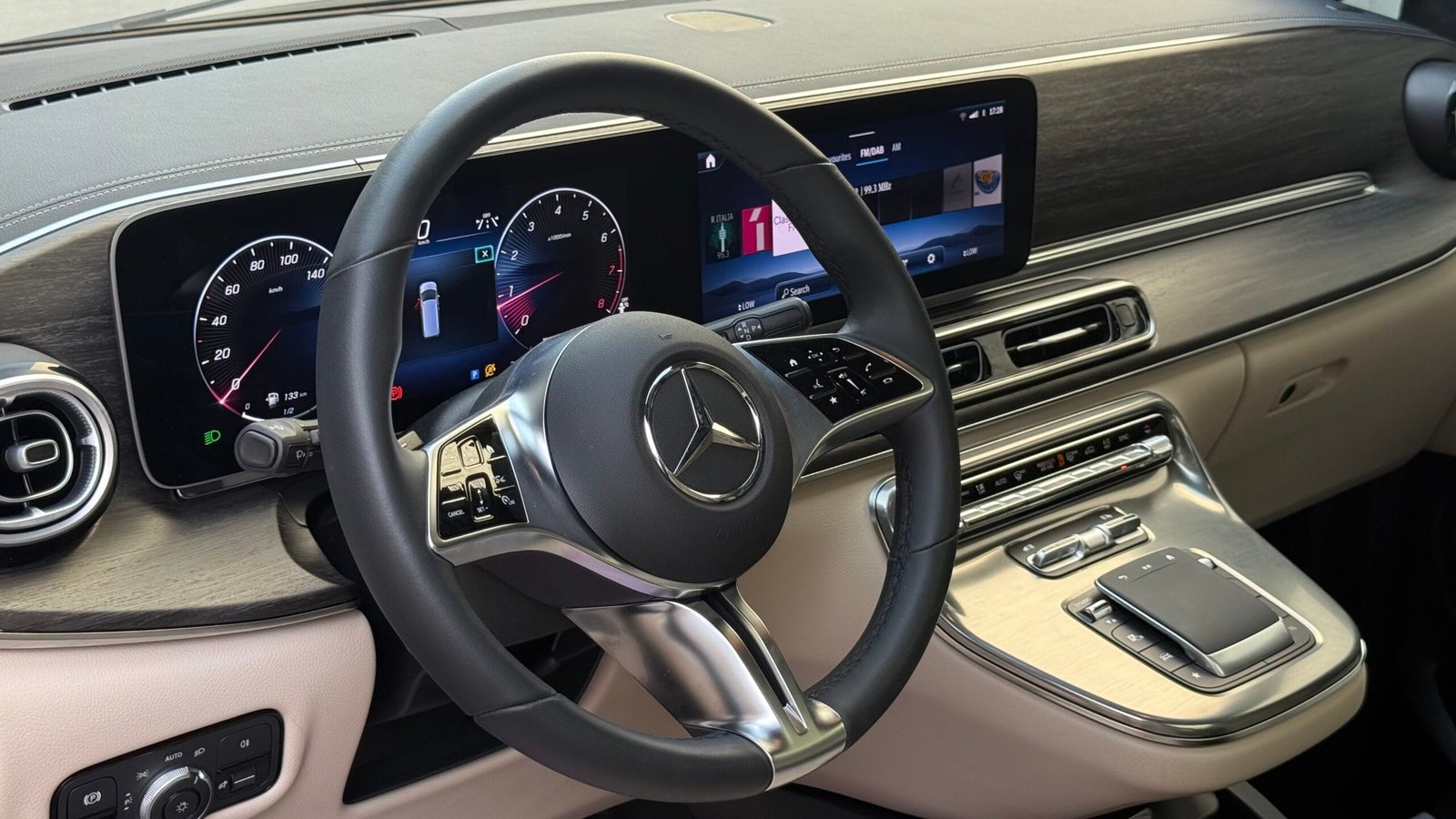
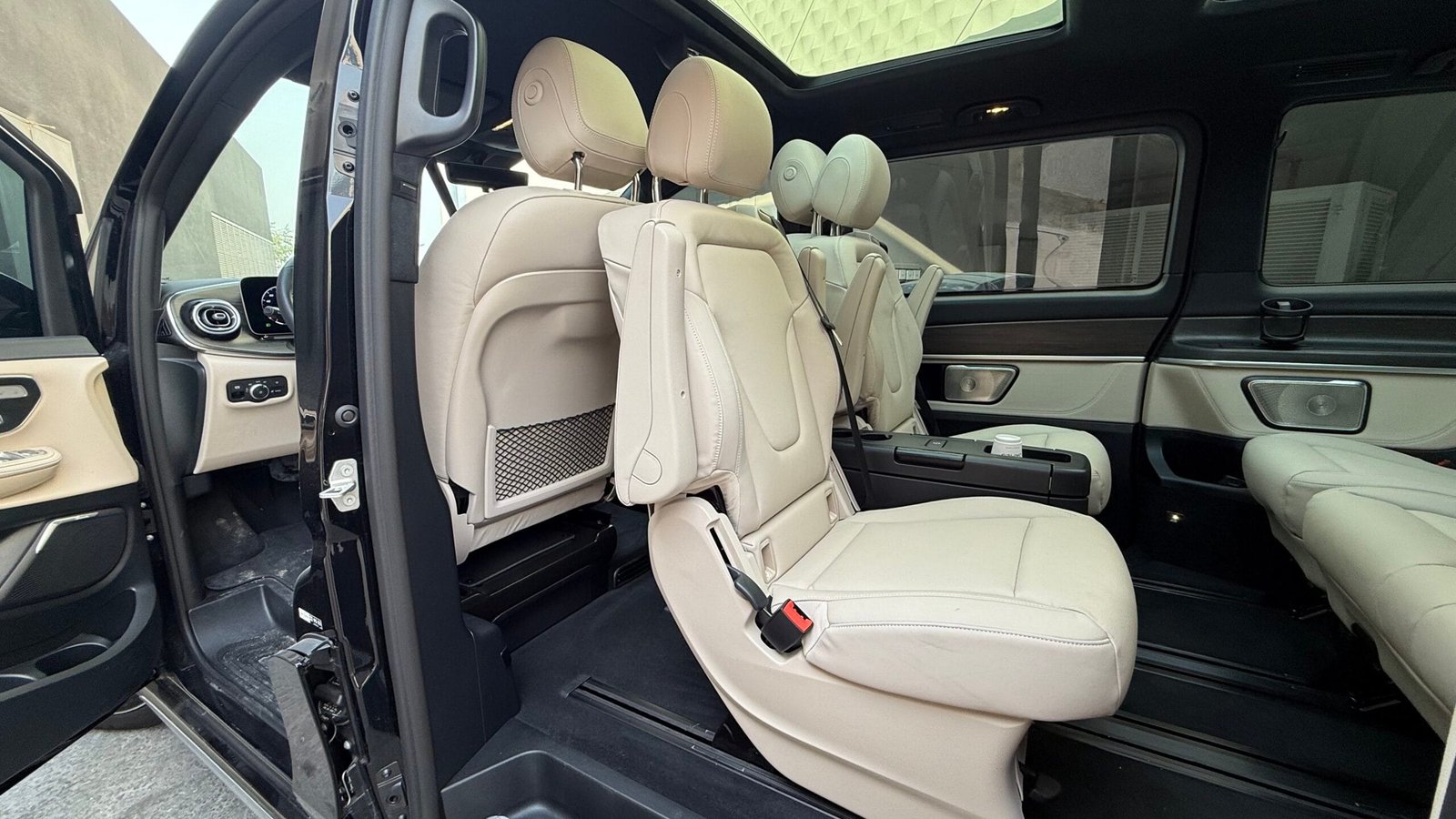
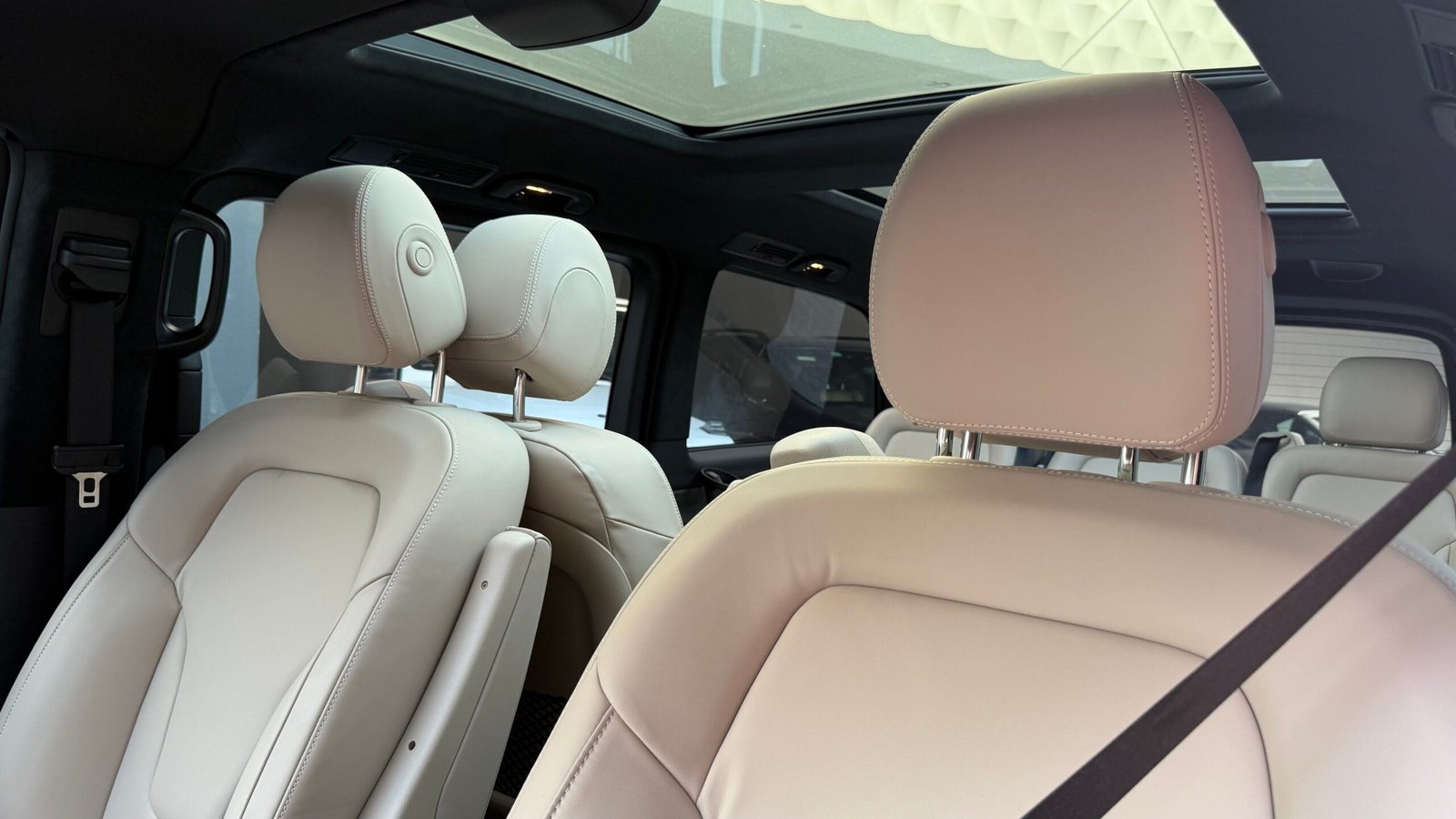
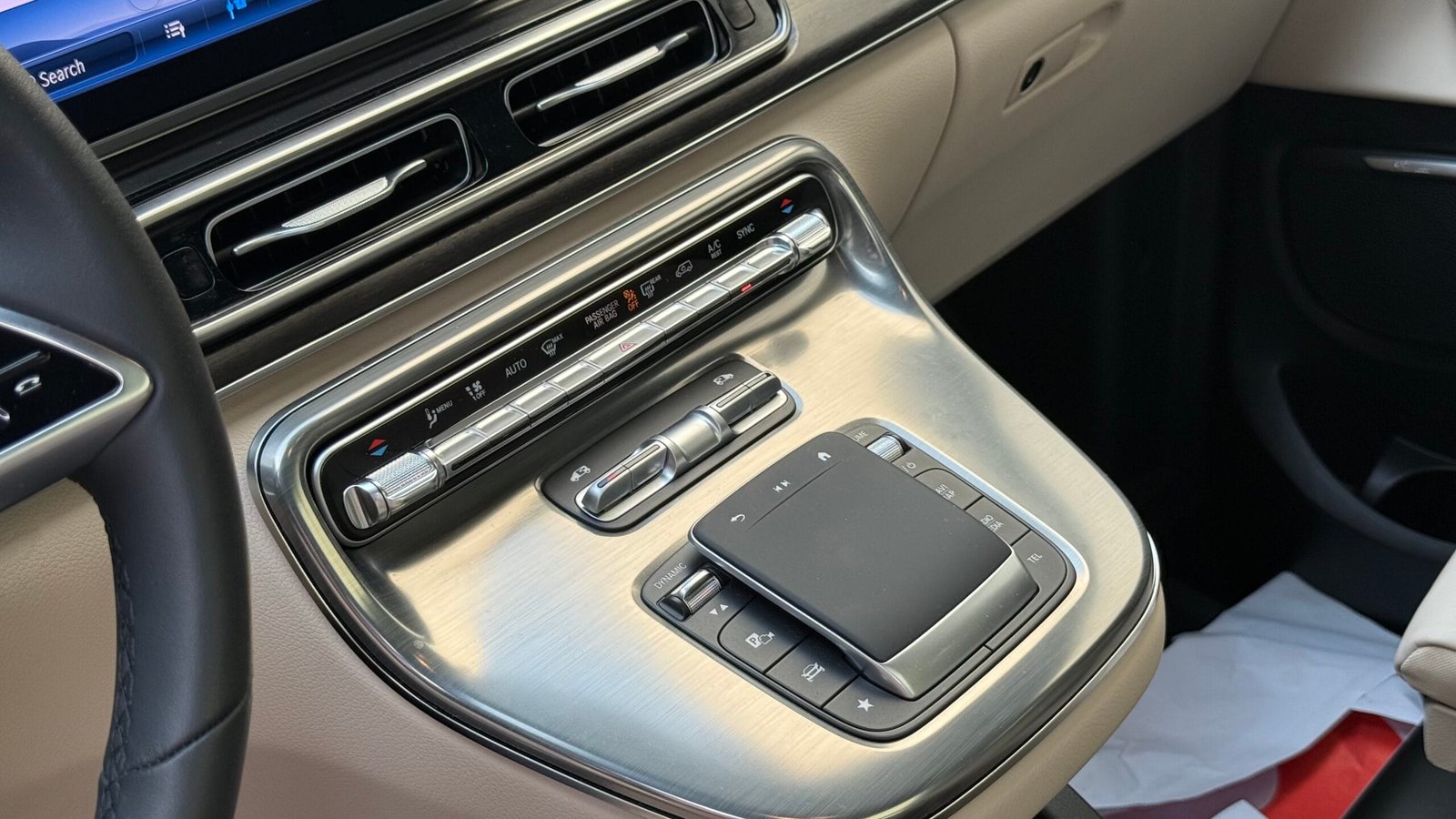
Advanced Infotainment and Connectivity
At the heart of the V-Class’s tech is the latest MBUX (Mercedes-Benz User Experience) system, now standard equipment. This next-generation interface offers a highly interactive experience with features like ENERGIZING comfort control (integrating climate, lighting and seats for wellness) and augmented-reality navigation . The multimedia system supports seamless Apple CarPlay and Android Auto wirelessly, plus full smartphone mirroring, yet MBUX’s own apps and browser ensure passengers remain connected without phones . Voice control (“Hey Mercedes”) is also improved, and users can save personalized driver profiles with settings and last-used destinations . Additional connected services – accessible via the Mercedes me app – include over-the-air updates, remote door lock/unlock, and Mercedes me Charge (for EQV) access to 620,000+ European charging points .
- MBUX Highlights: Central touchscreen with crisp graphics, haptic steering controls, and “Hey Mercedes” voice assistant; AR navigation overlay on live camera view .
- Connectivity: Multiple user profiles, Mercedes me remote services (e.g. remote door unlock, window control) and navigation with real-time traffic .
- Audio: Available Burmester surround sound with high customizability for an immersive cabin experience .
Powertrain Options and Performance
The new V-Class lineup offers a choice of powertrains to suit different markets and preferences. In core markets (Europe and Asia), diesel remains standard: a 2.0-liter 4-cylinder (OM654) in three tunes – 163 hp (120 kW), 190 hp (140 kW) and 237 hp (174 kW) – all with nine-speed 9G-TRONIC automatic transmission . These engines provide robust low-end torque (up to 500 Nm in the V300d), yielding smooth, responsive acceleration for a large vehicle . Mercedes claims combined fuel consumption of about 6.9–8.7 L/100 km (WLTP) for the diesel range . (Real-world testing suggests around 11–12 L/100 km in city use , typical for a heavy MPV.)
A new petrol option (M254 2.0L mild-hybrid with 231 hp) arrives in 2024 , tailored for markets like Asia and China where fuel is favored. All combustion variants are rear-wheel drive; a 4MATIC all-wheel-drive is available on diesel models for improved traction . The 9G-TRONIC gearbox and multiple chassis/driving modes ensure balanced ride and handling – Mercedes highlights a plush suspension setup that isolates passengers from road bumps .
For zero-emissions duty, the fully electric EQV shares the V-Class body. It offers two battery options (90 kWh or 60 kWh) delivering up to 204 hp (150 kW) with 95 kW continuous power . With efficient recuperation and thermal management, the EQV’s WLTP range is up to about 365 km on the larger pack . It supports up to 11 kW AC and 110 kW DC fast charging (10–80% in ~40 minutes). The EQV also has EV-specific MBUX displays (for range, charging, etc.) and uses Mercedes me Charge for seamless public charging access .
- Diesel Power: OM654 2.0L in 163–237 hp, 9-speed auto, RWD (4MATIC optional) .
- Petrol Hybrid: New M254 2.0L mild-hybrid (231 hp) for markets like China .
- Electric EQV: 150 kW motor with 60/90 kWh battery, ~277–365 km range (WLTP) .
Comfort and Practicality
The V-Class prioritizes passenger comfort and utility. The long wheelbase and tall roof yield generous interior volume: with all seven seats in place there is about 1,030 liters of luggage space (expandable to over 4,600 L with seats folded) . Cabin noise is well suppressed, allowing a conversation-friendly environment (especially compared to older diesels) . Ride quality is notably smooth – the suspension is tuned for compliance, giving a “truly plush” ride even in sportier trims .
The flexible seating arrangement is a highlight. Standard is a 2-3-2 layout (driver + six passengers) in 7-seat spec . A 6-seat luxury option replaces the middle-row bench with two executive captain’s chairs, each heated, ventilated and fully reclining (with optional massage) . A fold-out table, multi-zone climate control (four zones) and plentiful cupholders/USB-C ports ensure rear passengers stay comfortable and connected . Multiple stowage cubbies, wide sliding doors, and an easy-touch tailgate (with optional hands-free operation) add to everyday convenience for families or shuttle services.
- Seating Configurations: Versatile layouts (e.g. 7-seat bench or 6-seat luxury captain chairs) with generous legroom and headroom .
- Space & Storage: Large luggage capacity, fold-flat seats, overhead storage, and numerous cupholders/compartments for passengers’ belongings.
- Ride Comfort: Even on rough roads the V-Class soaks up bumps; rear passengers can relax in stability and quiet, ideal for VIP transport .
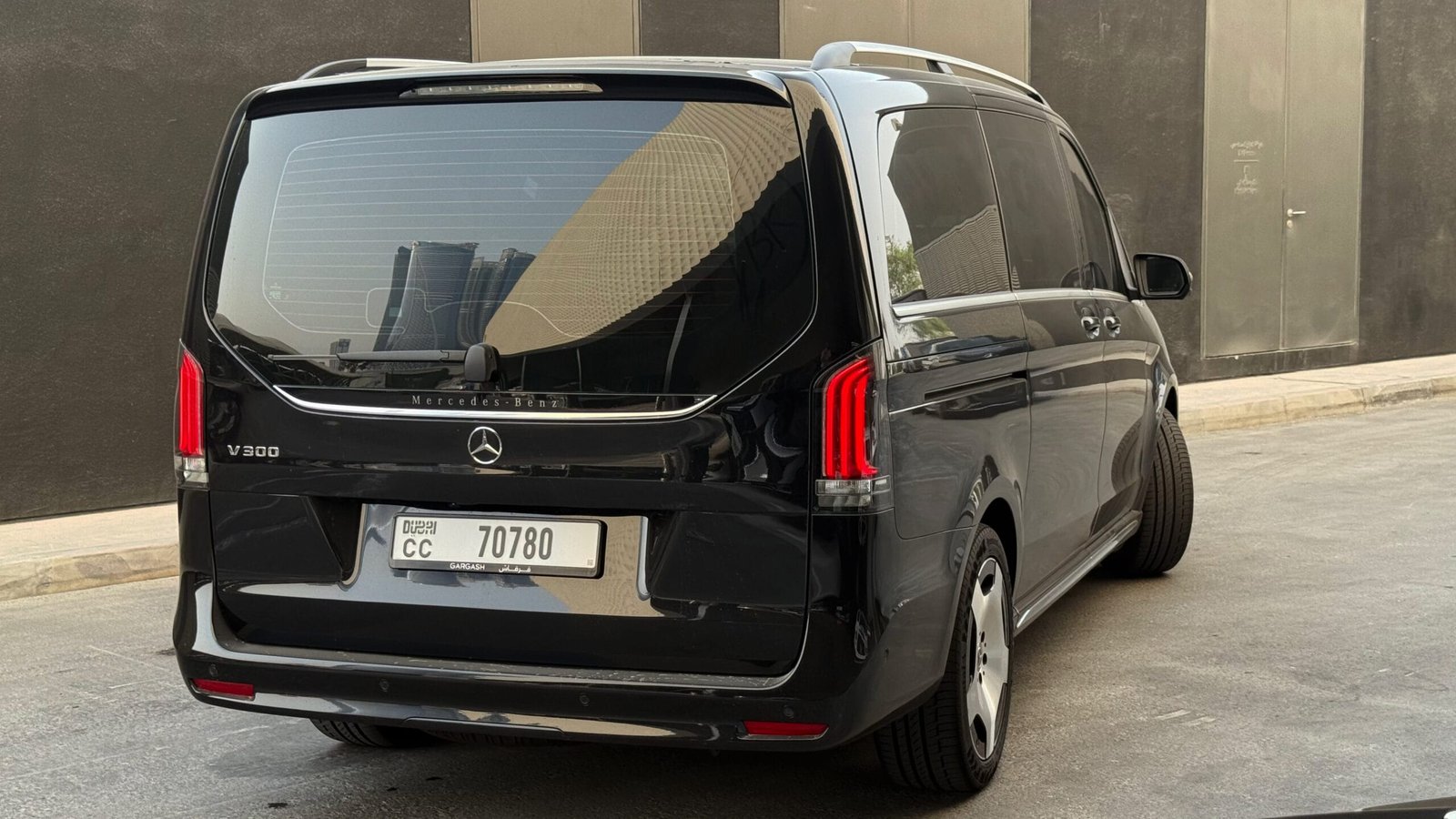
Safety and Driver-Assistance
Mercedes equips the new V-Class with an extensive suite of safety technologies, many of them standard. Features include Active Brake Assist (now with cross-traffic detection), Active Distance Assist DISTRONIC adaptive cruise control, Blind Spot Assist, Lane Keeping Assist, and Intelligent Speed Assist . Attention Assist (driver drowsiness warning) and Headlamp Assist (auto high-beam) are also standard. Options like the 360° parking camera and Trailer Manoeuvring Assist aid complex maneuvers. Critically, these aids do not replace driver responsibility, but they add confidence during long journeys or in city traffic .
- Lighting: Standard or available MULTIBEAM LEDs with up to 84 segments, enabling precision high-beam without dazzling oncoming traffic .
- Passive Safety: The V-Class has a robust build, 7 airbags (front, side, window, curtain), and rigid passenger cell, meeting or exceeding modern safety standards .
- Driver Aids: Adaptive cruise with Stop&Go, active steering support, Forward Collision Warning (with seatbelt pretensioning), and pedestrian/cyclist detection are on offer .
Trim Levels and Target Audiences
The facelifted V-Class comes in multiple trim and equipment lines to match its multi-role nature . Trim levels include base, STYLE, AVANTGARDE, EXCLUSIVE, and optional AMG Line or Night Package styling. Executive Transport variants emphasize luxury – for example, an Exclusive VIP model adds Nappa leather, Burmester sound, and special 19″ wheels . By contrast, the standard and Style models are well-equipped for family use, with durable leatherette seats and practical features. Mercedes notes that the customer base spans from families and leisure users to CEOs and VIPs, and the equipment has been tailored accordingly . Even the Marco Polo camper (factory-built conversion) is based on the new V-Class chassis, blending premium travel with adventure.
Competitors of the V-Class in the Luxury MPV Segment
In the luxury people-mover segment, the V-Class’s closest rivals are few but notable. Traditional alternatives include the Volkswagen Caravelle/Multivan and Toyota’s premium people carriers (e.g. the Alphard/Vellfire in Asia). Autotrader South Africa emphasizes that in many markets “the Caravelle and Quantum pose the only real threat” to the stately V-Class . More recently, VW’s new ID.Buzz Electric MPV and Ford’s high-end Transits (as well as upcoming Mercedes VAN.EA-based models) are expanding choices. However, none yet match the V-Class’s combination of brand cachet, feature set and overall refinement. Mercedes’s focus on a fully premium strategy — along with an eye toward a future electric VAN architecture (VAN.EA from 2026) — aims to keep the V-Class at the top of its class for luxury family and executive transport .
In summary, the all-new V-Class is a comprehensively updated luxury van designed to excel as both a family MPV and a chauffeured executive shuttle. With its refreshed styling, high-end interior, latest MBUX tech, and broad powertrain choices (including diesel, petrol mild-hybrid and pure electric), it delivers performance, efficiency and comfort in equal measure. Enhanced safety systems and flexible seating configurations further reinforce its appeal across multiple use cases. This positions the V-Class firmly as the benchmark for premium people carriers in today’s market.
Mercedes Vision V: The Future of Smart Luxury in an Electric Van

